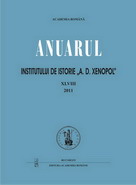Peţitorii nepoatei lui Ştefan cel Mare în 1517. Despre căsătoria lui Alexandru cu fiica lui Bartolomeu Drágfi
THE SUITORS OF STEPHEN THE GREAT’S GRANDDAUGHTER IN 1517. ON ALEXANDER’S MARRIAGE TO THE DAUGHTER OF BARTHOLOMEW DRÁGFI
Author(s): Marius DiaconescuSubject(s): History
Published by: Editura Academiei Române
Keywords: Stephen the Great; Bartholomew Drágfi; marriage; Moldavian-Hungarian relationship; Kanizsai; franciscan monastery in Bacau
Summary/Abstract: The Moldavian chronicles mention Bartholomew Drágfi, the voivode of Transylvania, on the occasion of his mediation in the conflict between Moldavia and Poland in 1497 as in-law of Stephen the Great. The historians have read this as signalling that Stephen’s son, Alexander, married to a daughter of Bartholomew Drágfi. Starting with 1974, the historian Ştefan S. Gorovei contested this matrimonial relationship in a number of instances. A hitherto unpublished document from 1517, preserved only fragmentarily, confirms this matrimonial alliance. The Moldavian envoys sent to Thomas Bakócz, Archbishop of Esztergom, narrated about the daughter that had born out of this marriage, a nubile herself, to which Stephen the Great demised wealth and strongholds. The document reports mistakenly about the marriage: John Drágfi’s sister married Stephen the Great. The successive transmission of rumours generated the confusion. The one concerned was in fact Stephen the Great’s son. Cardinal Thomas Bakócz spread the word about how the sons of the Hungarian magnates were expected to court this lovely and wealthy girl. Clare Kanizsai was very interested in marrying her son, Ladislaus Kanizsai. Already in 1515 she tried to obtain the girl’s hand through the medium of John Drágfi. In the correspondence generated by this courtship, John Drágfi calls “brother” the Moldavian prince (Bogdan III, the son of Stephen the Great), which is another proof of the matrimonial relationship connecting the Drágfi family to that of Stephen the Great. The endeavours of the Kanizsai family were fruitless, and in the end, presumably as compensation, John Drágfi married his younger sister, Anne, to Ladislaus Kanizsai. We assume that the marriage of Stephen the Great’s son to the daughter of Bartholomew Drágfi was a matrimonial arrangement with political ends. Bartholomew Drágfi was well aware of the part played by his ancestors in establishing the Moldavian principality at the middle of the 14th century and so this marriage could have appeared as a recovery of their one-time land. Taking into account the significant political position held by Bartholomew Drágfi at the royal court and his close relations with King Matthias Corvinus, we consider that he was instrumental in the negotiations and subsequent granting of the two Transylvanian castles – Ciceu and Cetatea de Baltă – by the Hungarian monarch to the Moldavian prince. Of course, these are suppositions, but with a high degree of probability.
Journal: Anuarul Institutului de Istorie »A.D. Xenopol« - Iaşi
- Issue Year: XLIX/2012
- Issue No: 49
- Page Range: 55-77
- Page Count: 18
- Language: Romanian

